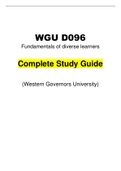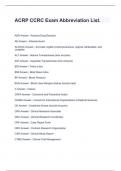lOMoARcPSD|200261 51 WGU D096 Fundamentals of diverse learners Complete Study Guid e (Western Governors University) lOMoARcPSD|200261 51 D096 Study Guide Unit 2, Module 1 1. What does the term English learner (EL) mean? What are some other terms used to refer to these students? (p. 11) a. The term English learner means is a student whom first language isn’t English. A student who is limited English proficient. Who is age 3-21., Who comes from a environment where a language other than English has had a significant impact on the individual level of English language proficiency? b. ELL, ESOL, ESL, LEP are other terms used for EL students. 2. Federal law requires that parents be notified their child has been identified as an English learner within what time period? (p. 12, Essential Reading 1) a. Parents must be notified that their child has been identified as an English learner within 30days of the beginning of the school year and w ithin 2 weeks for students that enroll during any other time during the school year. The schools are required to provide parents with a host of information regarding their child’s level of English proficiency and how this was determined, the type of progra m that their child is enrolled or recommended too participate in, the method of instruction, and more 3. Describe one screening tool commonly used as the first step to identify English learners. What is it called? Who completes it? What are some of the questions it includes? (p. 12, Essential Reading 1) a. Home Language Survey —questions: What language did your child first understand or speak? What language do you or others use most often when speaking with your child? b. Parents -What language does your child use most often when speaking with other family or other members? 4. After a student is identified as a potential EL, how are placement or screener tests used for further evaluation? (p. 12, Essential Reading 2) a. Once students are identified as potential El students they must be assessed with a valid and reliable assessment to determine if they are indeed Els. They test the students in proficient in language domains (speaking, listening, reading and writing) 5. What is the purpose of Title III of Every Student Succeeds Act or ESSA (2015) as it relates to the education for ELs? (p. 12, Essential Reading 2, Page 35) a. It deals with Language instruction for English learners and Immigrants Students. It regulates the main aspects that have to do with EL sessions that schools provide to students whose first language is not English 6. If a student is identified as EL and is diagnosed with a disability but the parent declines disability -related services, what is the school still required to provide? (p. 14, Essential Reading 1, Page 2) a. If the parents decline disability -related services under IDEA and 504, the SEA and LEA remain obligated to provide appropriate language assistance services to Els. Make it Happen!! lOMoARcPSD|200261 51 7. If a student is identified as EL and is diagnosed with a disability but the parent opts out of the EL programs and services, what is the school still required to provide? (p. 14, Essential Reading 1, Page 2) a. The LEA remains obligated to provide such services as required in the IEP or 504 plan, and to conduct ELP monitoring and / provide language ass istance as appropriate. 8. What are some ways we can overcome the overidentification and under -identification of ELs in special education? (p. 14, Essential Video) a. The resources. Available for low -income area are at a shortage -Most school aren’t culturally responsive for the increase of El student populations. And it results in under identification of these students. And people are nervous because they don’t want to put a label on the EL students since they aren’t educated on the identifying these EL students 9. Describe the 6 key principles for teaching ELs. (p. 16, Essential Reading 1) 1. Instruction focuses on providing Els with opportunities to engage in discipline - specific practices, which are designed to build conceptual understanding and language competence in tandem. Learning is a social process that requires teachers to intentionally design learning opportunities that integrate reading, writing, speaking, and listening with the practices of each discipline. 2. Instruction leverages ELs’ home language(s), cultural assets, and prior knowledge. ELs’ home language(s) and culture(s) are regarded as assets and are used by the teacher in bridging prior knowledge to new knowledge, and in making content meaningful and comprehensible. 3. Standards -aligned instruction for ELs is rigorous, grade -level appropriate, and provides deliberate and appropriate scaffolds. Instruction that is rigorous and standards -aligned reflects the key shifts in the CCSS and NGSS. Such shifts require that teachers provide students with opportunities to describe their reasoning, share explanations, make conjectures, justify conclusions, argue from evidence, and negotiate meaning from complex texts. Students with developing levels of English proficiency will require instruction that carefully supports their understanding and use of emerging language as they participate in these activities. 4. Instruction moves ELs forward by taking into account their English proficiency level(s) and prior schooling experiences. ELs within a single classroom can be heterogeneous in terms of home language(s) proficiency, proficiency in English, literacy levels in English and student’s home language(s), previous experiences in schools, and time in the U.S. Teachers must be attentive to these differences and design instruction accordingly. Make it Happen!! lOMoARcPSD|200261 51 5. Instruction fosters ELs’ autonomy by equipping them with the strategies necessary to comprehend and use language in a variety of academic settings. ELs must learn to use a broad repertoire of strategies to construct meaning from academic talk and complex text, to participate in academic discussions, and to express themselves in writing across a variety of academic situations. Tasks must be designed to ultimately foster student independence. 6. 6. Diagnostic tools and formative assessment practices are employed to measure students’ content knowledge, academic language competence, and participation in disciplinary practices. These assessment practices allow teachers to monitor students’ learning so that they may adjust instruction, accordingly, provide students with timely and useful feedback, and encourage students to reflect on their own thinking and learning. Unit 2, Module 2 1. List the important components of the Individuals with Disabilities Education Act (IDEA). (p. 18, Essential Reading 1) a. It’s a education law that requires public school to meet the unique needs of eligible K-12 students with disabilities. i. Legal rights for people with disabilities ii. An Individualized Education program (IEP) for eligible K-12 students iii. Special education and related services to meet a students’ unique needs iv. Accommodation (audiobooks or extra time) for K-12 students v. A requirement that public schools find and evaluate -at no cost to families - kids who may have a disability vi. Education funding for schools vii. A free appropriate public education (FAPE) in the least restrictive environment (LRE) for students viii. Procedural safeguards that protect families’ rights (like access to school records) ix. Due process (or partial hearing) for resolving disputes between families and schools 2. List the important components of Section 504 of the Rehabilitation Act. (p. 18, Essential Reading 1) a. 504 Plan-is a civil rights law prohibits disability discrimination at schools that get federal funding. (School help by removing barriers) i. Legal rights for people with disabilities ii. 504 plans for eligible K-12 students iii. Accommodations (audiobooks or extra time) for K-12 students iv. A free appropriate public education (FAPE) in the least restrictive environment (LRE) for students v. Procedural safeguards that protect families right (like access to school records) Make it Happen!!





